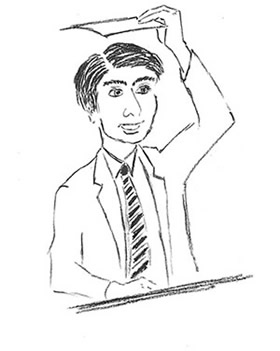103 Points of order
While the Senate is dividing senators may speak sitting to a point of order arising out of or during the division.
Amendment history
Adopted: 19 August 1903 as SO 172
1989 revision: Old SO 180 renumbered as SO 103
Commentary
The rationale for this rule is that a senator standing, which senators normally must do to seek the attention of the chair, would not be conspicuous when senators are taking their places in the chamber to vote.

Covering the head during divisions to take a point of order has never been partof Senate procedures (Illustration by Wayne Hooper)
The 1938 MS provides an interesting commentary on points of order during divisions including the “mistaken” practice of covering the head with a sheet of paper. Edwards traced the history of this standing order to the House of Commons where a member may speak sitting and “covered” (wearing a hat) when a point of order arises during a division. He noted that when preparing the standing orders for both Houses of the Australian Parliament, the Joint Standing Orders Committee[1] retained the practice but without the provision that the member must be “covered”. Edwards recorded that instances had been noted in the Commonwealth Parliament “where a Member who desires to speak during a division covers his head with a sheet of paper”. Edwards concluded that such practices were due to a “mistaken impression” that the practice of the British Parliament applies in Australia and emphasised that “this is not so”.
In its First Report of 1997, the Procedure Committee addressed the issue of points of order being taken and ruled on by the chair while the bells are ringing for a division and the possibility that senators may be misled by what would appear to be debate continuing during the ringing of the bells. The Procedure Committee recognised that a senator must have the right to raise a point of order while the bells are ringing, as there may be some irregularity in the putting of the question or the calling of the division to which the attention of the chair should be drawn. In order to overcome any difficulties, the Procedure Committee recommended that the President adopt the practice of deferring any discussion and ruling on a point of order until the end of the four minutes when the bells have ceased ringing. If a point of order then takes more than a few minutes to resolve, the question should be put again and the division taken anew, depending on the effect of the ruling.[2]
A point of order raised during a division must relate to the division, and cannot refer to some matter which has occurred earlier.[3]